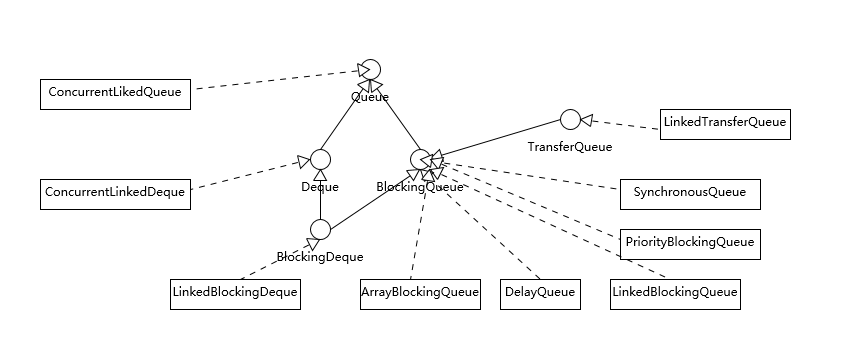并发包中的ConcurrentLinkedQueue和LinkedBlockingQueue有什么区别? - 《Java 核心技术》笔记
- Concurrent* 容器,基于lock-free,在常见的多线程访问场景,一般可以提供较高吞吐量;
- LinkedBlockingQueue内部基于锁,并提供了BlockingQueue的等待性方法。
Concurrent* 性质
java.util.concurrent包提供的容器(Queue、List、Set)、Map从命名上可以大概分为Concurrent* 、CopyOnWrite和Blocking等三类:
- Concurrent没有类似CopyOnWrite之类容器相对较重的修改开销;
- Concurrent提供了较低的遍历一致性。比如当利用迭代器遍历时,如果容器发生改变,迭代器仍然可以继续进行遍历;
- 与弱一致性对应的,是同步容器常见的“fail-fast”,检测到容器在遍历中发生了修改,则抛出ConcurrentModificationException,不再遍历;
- size等操作准确性有限;
- 读取的性能具有一定的不确定性。
线程安全队列(Queue)

绝大部分Queue都是实现了BlockingQueue接口。Blocking意味着提供了特定的等待性操作,take时等待元素进队,put是等待队列出现空位。
是否有界
- ArrayBlockingQueue是典型的有界队列,内部以final的数组保存数据,创建时就制定了容量;
- LinkedBlockingQueue,其内部行为和代码都是基于有界的逻辑实现的,但是如果在创建时没有指定容量,则会被自动设置为Integer.MAX_VALUE。成为无界队列;
- SynchronousQueue,每个删除操作都要等待插入操作,每个插入也都要等待删除操作。这个队列容量是0;
- PriorityBlockingQueue,无边界;
- DelayedQueue、LinkedTransferQueue,无边界。
实现——BlockingQueue一般都基于锁
LinkedBlockingQueue的实现:
/** Lock held by take, poll, etc */ private final ReentrantLock takeLock = new ReentrantLock(); /** Wait queue for waiting takes */ private final Condition notEmpty = takeLock.newCondition(); /** Lock held by put, offer, etc */ private final ReentrantLock putLock = new ReentrantLock(); /** Wait queue for waiting puts */ private final Condition notFull = putLock.newCondition();
与ArrayBlockingQueue不同,后者的notEmpty、notFull都是同一个再入锁的条件变量。而LinkedBlockingQueue改进了锁操作的粒度,头、尾操作使用不同的锁。
LinkedBlockingQueue的take操作:
public E take() throws InterruptedException {
final E x;
final int c;
final AtomicInteger count = this.count;
final ReentrantLock takeLock = this.takeLock;
takeLock.lockInterruptibly();
try {
while (count.get() == 0) {
notEmpty.await();
}
x = dequeue();
c = count.getAndDecrement();
if (c > 1)
notEmpty.signal();
} finally {
takeLock.unlock();
}
if (c == capacity)
signalNotFull();
return x;
}
代码中的选择
- 边界:ArrayBlockingQueue有明确的容量限制,而LinkedBlockingQueue取决于创建的时候是否指定;
- 空间利用:ArrayBlockingQueue比LinkedBlockingQueue紧凑,因为不需要创建节点,但是初始分配阶段需要一段连续内存,所以初始内存需求更大;
- 通用场景中,因为LinkedBlockingQueue头尾使用更细粒度的锁操作,所以吞吐量比ArrayBlockingQueue高;
- ArrayBlockingQueue性能比较好预测。
正文到此结束
热门推荐
相关文章
Loading...











![[HBLOG]公众号](https://www.liuhaihua.cn/img/qrcode_gzh.jpg)

